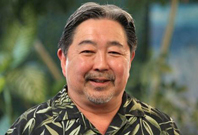 For Hawaii-native Kelvin Taketa, collaboration is a deeply ingrained value. "In Hawaii you grow up and you care about each other; you really rely on each other," he says. "It's a cooperative frame." Cooperation, collaboration, partnership—the Hawaii Community Foundation CEO lives by these concepts, and the Hawaii Technology Transformation Program is testament to what can be accomplished when different groups work toward a common goal. Established in early 2011 with the support of the Omidyar Ohana Fund, the Hawaii Community Foundation formed a partnership with the State of Hawaii to modernize the state's archaic business IT systems.
For Hawaii-native Kelvin Taketa, collaboration is a deeply ingrained value. "In Hawaii you grow up and you care about each other; you really rely on each other," he says. "It's a cooperative frame." Cooperation, collaboration, partnership—the Hawaii Community Foundation CEO lives by these concepts, and the Hawaii Technology Transformation Program is testament to what can be accomplished when different groups work toward a common goal. Established in early 2011 with the support of the Omidyar Ohana Fund, the Hawaii Community Foundation formed a partnership with the State of Hawaii to modernize the state's archaic business IT systems.
How technology promotes equality
"Hawaii state government was absolutely in the dark ages when it came to technology," says Taketa. In fact, according to a recent article in HawaiiBusiness, 743 legacy systems have been identified—some of which are upwards of 20 years old and written in COBOL, a programming language that's now defunct. The state’s financial accounting and management information system is 30 years old, and the payroll system is 40 years old. Hiring procedures, payroll, and other business processes still center around paper, are "Kafkaesque" to navigate, and result in widespread inefficiencies. One result of all this: Inequity.[Related: Emmett Carson on Young Donors of Silicon Valley and Other Forces in Cutting-Edge Philanthropy.]
The lack of updated business and information technology systems has a profound effect on poor, rural, and Neighbor Island populations, says Taketa. "In Hawaii, especially in remote rural communities, if they're not able to access government virtually, they can't access benefits and resources," says Taketa. For example, those applying to Hawaii's food stamp program must submit an application in person and have a face-to-face interview with a state employee. For a person living in Hana, for example, this requires a three-hour drive each way to Wailuku. "In other states, though, that entire application process is done online," Taketa told HawaiiBusiness.
Playing the honest broker: Kelvin Taketa helped the Omidyars jumpstart the Hawaiian government’s technology revamp
Access the complete archive of Kelvin Taketa's videos.
Collaboration in action
To begin fighting this inequity, Taketa called on Hawaii resident Pierre Omidyar for funding. The eBay founder who, not surprisingly, champions the power of tech to bring people together and create efficiencies, agreed to fund the project (through the Omidyar Ohana Fund, which he and wife, Pam, established in 2009), and the Omidyars provided seed capital of more than $4 million. Taketa and his team also went to Governor Neil Abercrombie and asked if he would back these efforts, but with several conditions. The governor agreed and is a vocal champion of the project. “Transformation of state government is about delivering the services people need—anywhere, anytime,” he said at a summit last year.[Related: High-Stakes Donor Collaborations.]
The power of collaboration
"In effect, the Omidyar money paid for planning the transformation, including [the Office of Information Management and Technology]’s initial staffing, a baseline needs assessment and benchmarking report from SAIS, and the development of the all-important strategic plan," according to the HawaiiBusiness article. The state now has its first CIO, and the state Legislature agreed to contribute $25 million in supplemental funding. The 12-year business and tech transformation plan is ambitious and profound—it's correcting 40 years of underinvestment and will require widespread behavioral changes along with the new technology. And its start depended on collaboration.Omidyar brought funding; Taketa brought a long history of working with government and the soft skills to get unions on board; the Governor brought a willingness to tackle what was needed for the long haul. "The government had no money to start this effort; they could not have done this alone," says Taketa. "We brought resources to the table that allowed them to do something that ultimately is going to benefit everyone in Hawaii."
[Related: Three Insights on Impact Investing from eBay Founder Pierre Omidyar.]
Kelvin Taketa's Key Messages for Philanthropists
- Convene as a neutral actor. Watch: A neutral convener.
- Identify and fund collaboration. Watch: Not just collaboration: partnerships, Money isn’t enough, Playing the honest broker, and The lack of collaboration.
- Collect and share knowledge. Watch: The need to pay attention, On spreading out resources, and Adding knowledge to dollars.
- Welcome criticism from grantees. Watch: Happy to get criticism and Candid conversations.


